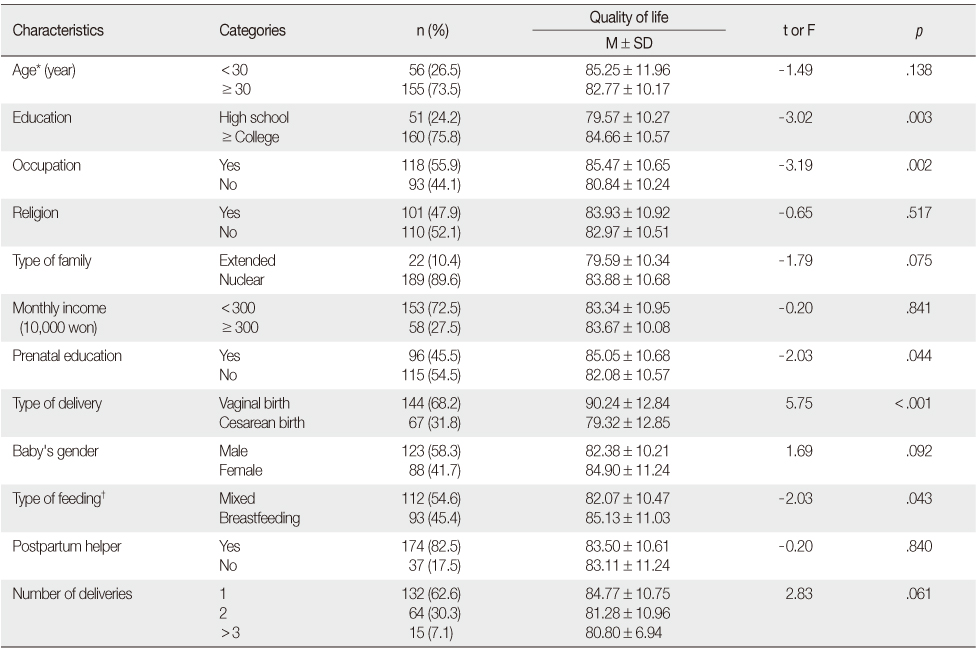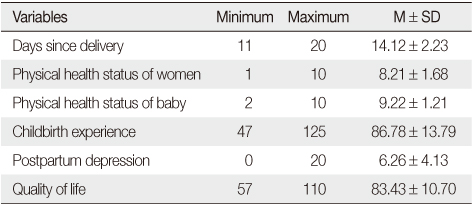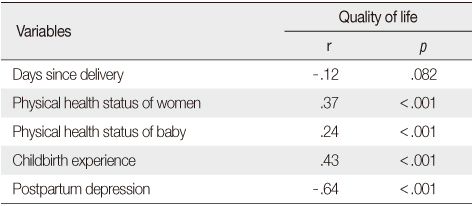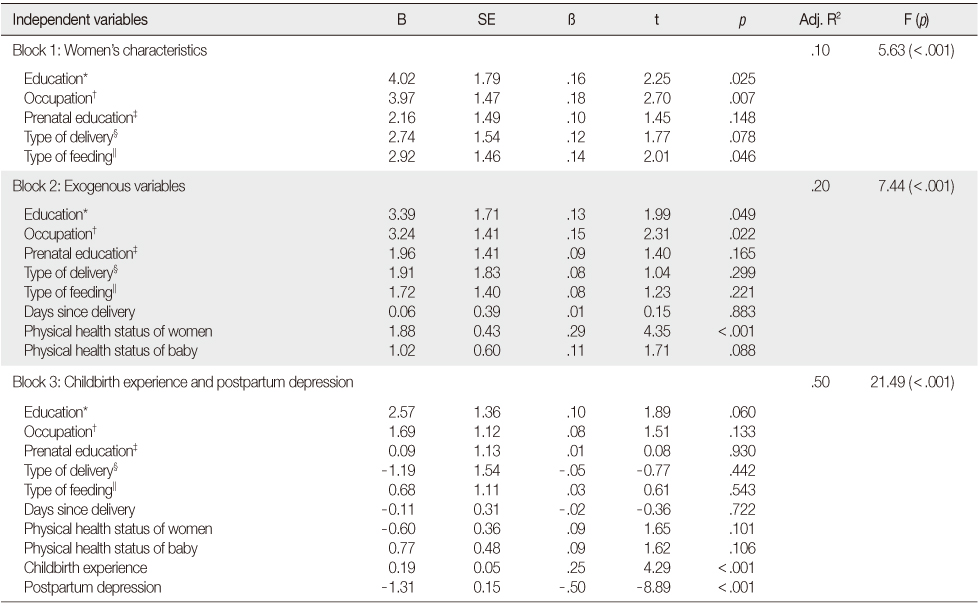Articles
- Page Path
- HOME > J Korean Acad Nurs > Volume 43(1); 2013 > Article
-
Original Article
- Influence of Childbirth Experience and Postpartum Depression on Quality of Life in Women after Birth
- Jung Hee Yeo, Nami Chun
-
Journal of Korean Academy of Nursing 2013;43(1):11-19.
DOI: https://doi.org/10.4040/jkan.2013.43.1.11
Published online: February 28, 2013
1Department of Nursing, Dong-A University, Busan, Korea.
2Department of Nursing, Sungshin Women's University, Seoul, Korea.
- Address reprint requests to: Chun, Nami. Department of Nursing, Sungshin Women's University, Unjung Green Campus Mia-dong Gangbuk-gu, Seoul 142-732, Korea. Tel: +82-10-5112-0724, Fax: +82-2-920-2092, nmchun@sungshin.ac.kr
© 2013 Korean Society of Nursing Science
Abstract
-
Purpose
- The purpose of this study was to identify influence of childbirth experience and postpartum depression on quality of life in women after birth.
-
Methods
- Two hundred and eleven postpartum women were asked to complete the questionnaires on their childbirth experience during their admission and on their postpartum depression and quality of life between one to three weeks after birth. Initial data were collected from February 1 to May 30, 2011 at two obstetric hospitals in Busan, Korea. Data were analyzed using t-test, ANOVA, Pearson correlation coefficients, and hierarchical multiple regression.
-
Results
- The women's childbirth experience and postpartum depression were identified as factors influencing quality of life after birth. The model explained 50% of the variables.
-
Conclusion
- Results suggest that childbirth educators should include strategies to increase a positive childbirth experience and to decrease postpartum depression in their education programs in order to improve women's quality of life.
- 1. Beck CT, Indman P. The many faces of postpartum depression. J Obstet Gynecol Neonatal Nurs. 2005;34(5):569–576. http://dx.doi.org/10.1177/0884217505279995.ArticlePubMed
- 2. Cho YS. The effects of the husband's emotional support on the prevention of postpartum depression: Using an experimental teaching intervention. 1988;Seoul, Ewha Womans University. Unpublished doctoral dissertation.
- 3. Choi SY, Gu HJ, Ryu EJ. Effects of fatigue and postpartum depression on maternal perceived quality of life (MAPP-QOL) in early postpartum mothers. Korean J Women Health Nurs. 2011;17(2):118–125. http://dx.doi.org/10.4069/kjwhn.2011.17.2.118.ArticlePubMed
- 4. Cox JL, Holden JM, Sagovsky R. Detection of postnatal depression. Development of the 10-item Edinburgh Postnatal Depression Scale. Br J Psychiatry. 1987;150:782–786. http://dx.doi.org/10.1192/bjp.150.6.782.ArticlePubMed
- 5. Coyle SB. Health-related quality of life of mothers: A review of the research. Health Care Women Int. 2009;30(6):484–506. http://dx.doi.org/10.1080/07399330902801260.ArticlePubMed
- 6. Da Costa D, Dritsa M, Rippen N, Lowensteyn I, Khalifé S. Health-related quality of life in postpartum depressed women. Arch Womens Ment Health. 2006;9(2):95–102. http://dx.doi.org/10.1007/s00737-005-0108-6.ArticlePubMedPDF
- 7. de Tychey C, Briancon S, Lighezzolo J, Spitz E, Kabuth B, de Luigi V, et al. Quality of life, postnatal depression and baby gender. J Clin Nurs. 2008;17(3):312–322. http://dx.doi.org/10.1111/j.1365-2702.2006.01911.x.ArticlePubMed
- 8. Dunbar GC, Stoker MJ, Hodges TCP, Beaumont G. The development of SBQOL-a unique scale for measuring quality of life. British J Med Econ. 1992;2:65–74.
- 9. Gamble J, Creedy DK. A counselling model for postpartum women after distressing birth experiences. Midwifery. 2009;25(2):e21–e30. http://dx.doi.org/10.1016/j.midw.2007.04.004.ArticlePubMed
- 10. Hardin AM, Buckner EB. Characteristics of a positive experience for women who have unmedicated childbirth. J Perinat Educ. 2004;13(4):10–16. http://dx.doi.org/10.1624/105812404x6180.Article
- 11. Hill PD, Aldag JC. Maternal perceived quality of life following childbirth. J Obstet Gynecol Neonatal Nurs. 2007;36(4):328–334. http://dx.doi.org/10.1111/j.1552-6909.2007.00164.x.ArticlePubMed
- 12. Howell EA, Mora P, Leventhal H. Correlates of early postpartum depressive symptoms. Matern Child Health J. 2006;10(2):149–157. http://dx.doi.org/10.1007/s10995-005-0048-9.ArticlePubMedPMCPDF
- 13. Kim JI. A validation study on the translated Korean version of the Edinbergh postnatal depression scale. Korean J Women Health Nurs. 2006;12(3):204–209.ArticlePDF
- 14. Kwon M, Kim HW, Kim NS, Jang JA. Postpartum depression and maternal role confidence, parenting stress, and infant temperament in mothers of young infants. J Korean Acad Child Health Nurs. 2006;12(3):314–321.
- 15. Marut JS, Mercer RT. Comparison of primiparas' perceptions of vaginal and cesarean births. Nurs Res. 1979;28(5):260–266. http://dx.doi.org/10.1097/00006199-197909000-00002.PubMed
- 16. McGovern P, Dowd B, Gjerdingen D, Gross CR, Kenney S, Ukestad L, et al. Postpartum health of employed mothers 5 weeks after childbirth. Ann Fam Med. 2006;4(2):159–167. http://dx.doi.org/10.1370/afm.519.ArticlePubMedPMC
- 17. Murray L, Cooper PJ. Postpartum depression and child development. 1997;New York, Guilford Press.
- 18. Oh HE, Sim GS, Kim JS. The effects of prenatal education on primiparas' perception of delivery experience, self-confidence and satisfaction in maternal role performance. Korean J Women Health Nurs. 2002;8(2):268–277.ArticlePDF
- 19. Oh JH, Lee HH, Kim YK, Min J, Park KO. The effect ofchildbirth education and family participated delivery in a labor-delivery-recovery room on primiparas' anxiety, labor pain and perception of childbirth experience. Clin Nurs Res. 2006;12(2):145–156.
- 20. Park YJ, Shin HJ, Ryu HS, Cheon SH, Moon SH. The predictors of postpartum depression. J Korean Acad Nurs. 2004;34(5):722–728.ArticlePDF
- 21. Reeder SJ, Martin LL, Koniak-Griffin D. Maternity nursing:Family, newborn, and women's health care. 1997;18th ed. Philadelphia, Lippincott Williams & Wilkins.
- 22. Soper DS. A-priori sample size calculator for hierarchical multiple regression (online software). 2012;Retrieved March 3, 2012. from http://www.danielsoper.com/statcalc3/.
- 23. Symon A, MacKay A, Ruta D. Postnatal quality of life: A pilot study using the Mother-Generated Index. J Adv Nurs. 2003;42(1):21–29.ArticlePubMedPDF
- 24. Tuohy A, McVey C. Experience of pregnancy and delivery as predictors of postpartum depression. Psychol Health Med. 2008;13(1):43–47. http://dx.doi.org/10.1080/13548500701294531.ArticlePubMed
- 25. Webster J, Nicholas C, Velacott C, Cridland N, Fawcett L. Quality of life and depression following childbirth: Impact of social support. Midwifery. 2011;27(5):745–749. http://dx.doi.org/10.1016/j.midw.2010.05.014.ArticlePubMed
- 26. World Health Organization Division of Mental Health. WHOQOL study protocol: The development of the World Health Organization quality of life assessment instruments (MNG/PSF/93.9). 1993;Geneva, World Health Organization.
- 27. Yoon JS, Kook SH, Lee MS. A preliminary study on Korean version of the SmithKline Beecham 'quality of life' scale (KvSBQOL). J Korean Neuropsychiatr Assoc. 1998;37(2):280–294.
- 28. Yoon JW. A prospective model of subjective life quality of clinical nurses. 2009;Daegu, Keimyung University. Unpublished doctoral dissertation.
- 29. Zubaran C, Foresti K. Investigating quality of life and depressive symptoms in the postpartum period. Women Birth. 2011;24(1):10–16. http://dx.doi.org/10.1016/j.wombi.2010.05.002.ArticlePubMed
REFERENCES
Figure & Data
REFERENCES
Citations

- The impact of obstetric violence on postpartum quality of life through psychological pathways
Shahnaz Kohan, Desirée Mena-Tudela, Samaneh Youseflu
Scientific Reports.2025;[Epub] CrossRef - The mediating effects of convergence of femininity-maternity and marital intimacy in the relationship between postpartum depression and quality of life in postpartum mothers: a cross-sectional study
Ye Jin Hong, Hae Ok Kim
Women's Health Nursing.2025; 31(1): 56. CrossRef - Obstetric violence in Finland: Analyzing the actions of healthcare staff in birthing narratives
Johanna Westergård, Jari Kylmä, Eija Paavilainen
Midwifery.2025; 148: 104498. CrossRef - Experiences of childbirth care among immigrant and non-immigrant women: a cross-sectional questionnaire study from a hospital in Norway
Kristin Reppen, Lena Henriksen, Berit Schei, Elisabeth Balstad Magnussen, Jennifer Jean Infanti
BMC Pregnancy and Childbirth.2023;[Epub] CrossRef - Factors Affecting Married Women’s Intention to Have a Second Child: Focusing on Reproductive Health Factors
Shinhwee Oh, So-Young Lee
Journal of The Korean Society of Maternal and Child Health.2023; 27(2): 110. CrossRef - Empirically derived dietary patterns and postpartum depression symptoms in a large sample of Iranian women
Shima Dehghan-Banadaki, Mahdieh Hosseinzadeh, Farzan Madadizadeh, Hassan Mozaffari-Khosravi
BMC Psychiatry.2023;[Epub] CrossRef - The effect of mindfulness-based counseling on the childbirth experience of primiparous women: a randomized controlled clinical trial
Bahare Sharegi Oskoui, Esmat Mehrabi, Roghaiyeh Nourizadeh, Khalil Esmaeilpour
BMC Pregnancy and Childbirth.2023;[Epub] CrossRef - Effect of Home-Based Education Program on Mothers’ Postpartum Quality of Life After Cesarean Delivery
Nilay ŞENER, Filiz OKUMUŞ
Gümüşhane Üniversitesi Sağlık Bilimleri Dergisi.2022; 11(1): 193. CrossRef - Postpartum Diet and the Lifestyle of Korean and Chinese Women: A Comparative Study
Jia Li, Heewon L. Gray, Sohyun Kim, Haeryun Park, Youngmi Lee, Hongmie Lee, Kyunghee Song
Frontiers in Public Health.2022;[Epub] CrossRef - Respectful maternity care and its relationship with childbirth experience in Iranian women: a prospective cohort study
Khadije Hajizadeh, Maryam Vaezi, Shahla Meedya, Sakineh Mohammad Alizadeh Charandabi, Mojgan Mirghafourvand
BMC Pregnancy and Childbirth.2020;[Epub] CrossRef - Caring behaviours by midwives: Jordanian women's perceptions during childbirth
Reham Khresheh, Lesley Barclay, Noordeen Shoqirat
Midwifery.2019; 74: 1. CrossRef - The influence of migration on women’s satisfaction during pregnancy and birth: results of a comparative prospective study with the Migrant Friendly Maternity Care Questionnaire (MFMCQ)
B. Gürbüz, C. Großkreutz, M. Vortel, T. Borde, R. C. Rancourt, H. Stepan, O. Sauzet, W. Henrich, M. David, V. Seidel
Archives of Gynecology and Obstetrics.2019; 300(3): 555. CrossRef - A Concept Analysis of Labor Support
Miyoung Chae, Horan Park
Korean Journal of Women Health Nursing.2018; 24(2): 138. CrossRef - Predictors of Quality of Life in Mothers of Premature Infant
Hyosin Choi, Yeonghee Shin
Korean Journal of Women Health Nursing.2017; 23(3): 191. CrossRef - Efficacy of a footbath for post‐partum fatigue in South Korea: A quasi‐experimental study
Eunsun Choi, Eunju Song
Japan Journal of Nursing Science.2017; 14(2): 126. CrossRef - Predictors of a negative labour and birth experience based on a national survey of Canadian women
Andrei Smarandache, Theresa H. M. Kim, Yvonne Bohr, Hala Tamim
BMC Pregnancy and Childbirth.2016;[Epub] CrossRef - The Impact of Postpartum Depression on Quality of Life in Women After Child's Birth
Zohreh Sadat, Masoumeh Abedzadeh Kalahroudi, Mahboobeh Kafaei Atrian, Zahra Karimian, Zahra Sooki
Iranian Red Crescent Medical Journal.2014;[Epub] CrossRef
Quality of Life in Women after Birth by Women's Characteristics (N=211)
*M±SD=31.30±3.29; †n=205 (noted discrepancy in number due to 6 missing data).
Descriptive Statistics of Main and Exogenous Variables (N=211)
Correlation between Main, Exogenous Variables and Quality of Life (N=211)
Factors Influencing Quality of Life in Women after Birth (N=205)
Reference group: *highschool; †no; ‡no; §cesarean section; ∥mixed.
*M±SD=31.30±3.29; †n=205 (noted discrepancy in number due to 6 missing data).
Reference group: *highschool; †no; ‡no; §cesarean section; ∥mixed.
 KSNS
KSNS
 E-SUBMISSION
E-SUBMISSION




 Cite
Cite

